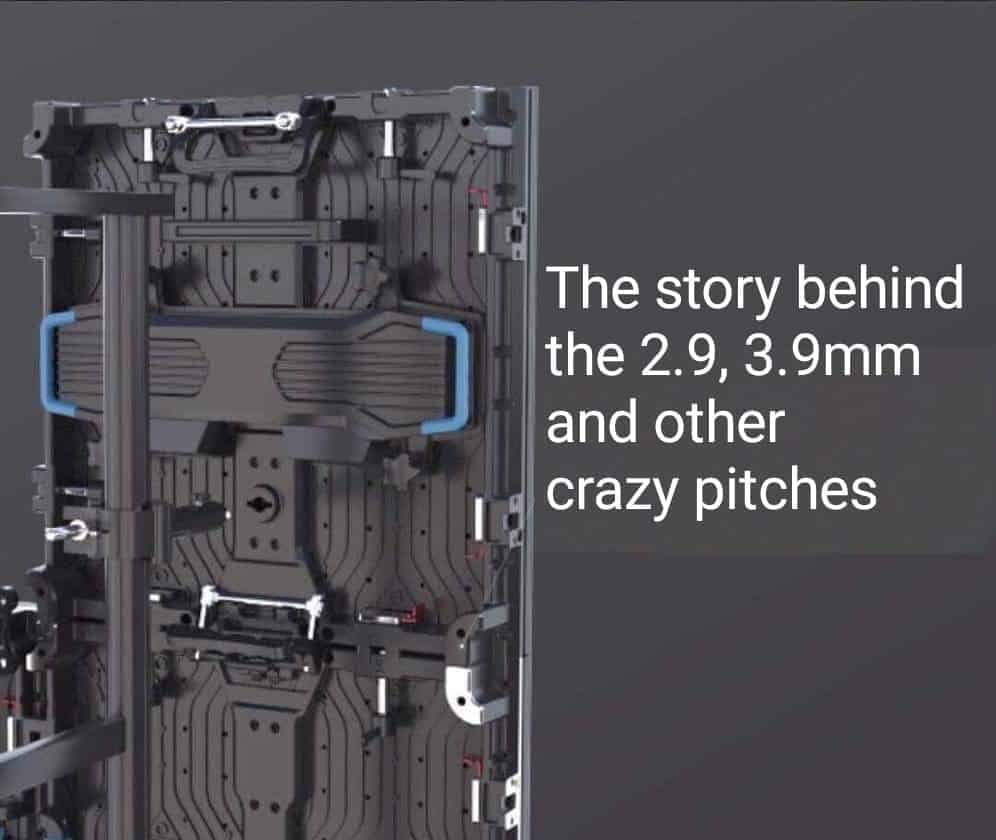Technical Level: 4/10
Reading Time: 10 mins
The origin story of the rise of the 1/2M (Half-Meter or 500mm) LED video wall panel, myriad non-rounded pixel pitches and comprehensive analysis of the pros and cons between the 2 designs.
Recently, clients have asked about the origin story behind the 2.9mm or 3.9mm pixel pitches and why these pitches are not rounded numbers like 3mm or 4mm?
The Backstory:
When early LED video wall innovators came up with the LED module concept, they used a pixel increment that corresponded to the driving capability of the IC chipset. Early ICs drove 8 pixels and then later 16 pixels.

To deviate from these increments would result in a waste of processing power. If there were 20 pixels (4 extra pixels) an additional IC would be needed. As such, 16*16 pixels and later 32*32 pixels became the industry norm for all LED modules.

Bear in mind, a customized cabinet can be tailor designed to fit the 1-module increment. This was especially useful when the size of a screen was confined to a particular space (limiting ceiling height etc.)
However, the downside was that myriad module sizes (For example 3mm at 192x192mm, or 4mm at 256x256mm ) would result in myriad cabinet sizes. (576x576mm at 3mm or 512x512mm at 4mm)
This becomes a nuisance, preventing salespeople from quickly generating proposals and factory managers from streamlining the production lines.
Enter the Half-Meter cookie cutter panel…
Rumor has it that in 2013, a large buying consortium of major Chinese Event Production companies had designed and invested in 2000SQM of 1/2M die-cast panels. That’s a significant total order of 8000 Panels!
The members of the consortium gained access to cross-rental panels without having to put up all the capital. The order size was unprecedented and thus a new trend in LED screen history was born.
The Europeans also applauded this move as they were already comfortable with the metric system. While the traditional pitches can result in myriad cabinet sizes. The new design locked in the 500mm (1/2M) panel across the board.
Thus, a 4mm, 512mm panel was reduced to a 3.9mm, 500mm panel. Others such as 6 reduced to 5.95mm, 5mm reduced to 4.81mm, 4 reduced to 3.91mm, 3 reduced to 2.97mm, etc.
Refer to the below chart: Left Column, you’ll see the standard 1/2M panel with the odd-numbered pitches, while on the Right Hand, you’ll see the traditional whole number pitches that result in various cabinet sizes.

Advantages of 1/2M panels:
- Easy to budget projects using 1/2 meter increments, especially in countries that are already on the metric system.
- Easy to swap out panels for different pitches without having to adjust the overall size of the screen.
- Fast conversion of per panel pricing to per SQM price and vice-versa. There are (4) 1/2M panels in one square meter. Therefore, a $500 a panel times 4 would yield $2000/SQM
- Standardization reduces factory inventory holding risk which encourages stocking and results in faster lead time.
- Cost reduction due to the economy of scale.
- Rounding down can be a marketing advantage. I.e. 3.9 dubbed as 3, and 4.8 as 4. (I emphasized “can” as I believe this unsavory tactic is misleading and preys on the ignorance of the buyer)
Disadvantages:
- Suppliers may only have 1/2M panels in stock, which they may steer the screen size towards.
Advantages of Traditional pitches:
- Customize sized cabinets built to the increment of the module (not the panel) can result in a more precise fit, especially relevant for fixed installations.
Disadvantages:
- Non-standard panels result in myriad SKUs, weight, power consumption, cost estimates, etc. As such, it’s difficult to produce quotes and complicates the production line. The high risk of non-selling induces suppliers to shy away from inventory.
- Longer than usual lead-time.
Bottom line:
For the Touring/Events/Rental/Production/Staging market, the 1/2M panel has become a norm and I would suggest not bucking the trend. However, in the fixed install market, there still can benefits for tailor-made projects to the increment of each individual module for a more precise fit.
A recent trend in the install market towards fine-pitch (sub 1.9mm) products has spurred the development of numerous “16:9” panels that are usually around 600mm in width, which is a large increment than even the 1/2M panels.
Tile or Module? “Tomayto, Tomahto!” Due to the lack of common industry lingo, the terms Tile and Module can cause some confusion. The lingo used can vary from between Touring Companies vs Fix Installation Integrator etc.
Rental/Production/Touring
Panel: Sometimes referred to as a chassis. Panel refers to the enclosure that an array of modules are mounted to. An array of Panels creates the screen. Module: the smallest Lego block consisting of an array of individual LEDs.
Also, called an I.M. and tile in Fixed-Installation.
Tile: Referred by some as a panel, especially in Live Event Production Companies.
Fixed Installation
Tile/Module: the smallest “Lego” block comprising an array of individual LED pixel. Often magnetic easy mounting.
Cabinet: the enclosure that an array of magnetic tiles (see above) are mounted to.
“Module” is commonly mistaken for cabinet for newbies.


If you have any more information or another version of the origin story of the half-meter panel, or any other pros and cons between the two, please let us know! Please share/like if you found it insightful!


